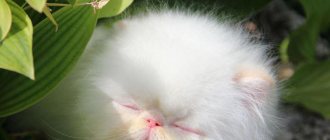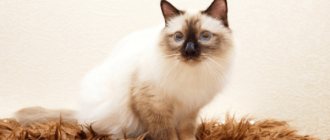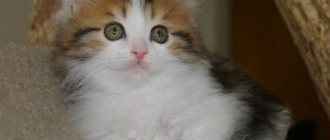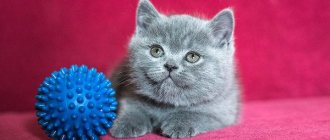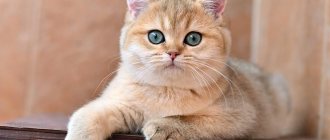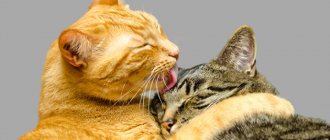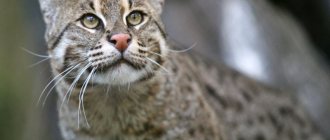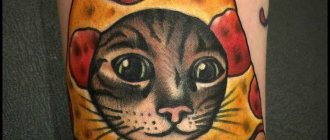- Pets
- >>
- Cat breeds
* Here is a photo of a typical representative of the Exotic cat breed . You can send us photos of your animals by email, and we will post them on the website. Don't forget to send your pet's name.
Other breed names:
Exotic
Video
* We invite you to watch a video about the Exotic cat . In fact, in front of you is a playlist in which you can select and watch any of 20 videos about a given cat breed by simply clicking on the button in the upper right corner of the window. In addition, the material contains quite a lot of photos. By looking at them you can find out what an Exotic cat looks like.
In this article:
|
Rate the material!
[Total votes: 2 Average: 5]
Color
The colors of the exotic breed are completely identical to the Persian: solid or multi-colored, marbled (with milky stripes), chocolate, tabby, gray, blue, black, “turtles”.
In the photo there is an exotic cat of popular colors
The cost of an exotic breed depends on several factors: blood purity, compliance with the established standard, color. The owner's expenses on food and medical care (vaccinations, childbirth) are also taken into account. You can buy an animal from a private breeder a little cheaper than in a nursery, but you should choose a seller carefully, having first studied the reviews. Otherwise, instead of an exotic one, you may get a trimmed Persian kitten. The cost of a baby can range from 7,000 to 50,000 rubles.
The history of the origin of exotic cats
The exotic breed was created through the efforts of American breeders in the 60s of the last century. Its full name is Exotic Shorthair. Parent breeds are Persians and shorthair cats: American, Burmese, Russian Blue. The first exotics were brought to Russia from Germany and Canada in the 80s of the last century.
Interesting fact: It all started when American breeders decided to diversify the color of the American Shorthair and, by crossing it with a chinchilla-colored Persian, got silver kittens. These kittens did not at all resemble an American and completely resembled a Persian both in figure and in the shape of their faces. But they have their own charming feature - dense, plush fur.
In 1966, the CFA adopted the breed standard and rules for its participation in exhibitions. The grades were given according to the Persian standard, excluding wool. The best lines of the new breed were established in the nurseries “New Dawn”, “Grayfire”, and Persian breeders from “Docia-Dao” and “Kalamar”, who raised the first exotic champions. In 1973, a feature such as “nose with stop” was added to the description of the breed standard, which also distinguished exotics from Persians.
At first, programs to develop a new breed included not only the American Shorthair, but also the Burmese and Russian Blue as sources of the shorthair gene. Although such crossings were not abused, attracting short-haired breeds only in the first stages of breeding. Crossing with American females was allowed until the early 80s, but later outcrosses with Persians were only allowed, as it was considered that the short hair gene was sufficiently established.
From time to time, individuals with long hair appear in the offspring of exotics. Since 2009, the CFA has created a separate show category for longhaired exotics sired by shorthairs and allowed them to compete in shows and receive their own awards. Perhaps they will still achieve recognition of their breed independence.
Where to buy an exotic kitten, and at what price
Despite the fact that the breed is very popular, the sale of exotic kittens is not common in Russia. Those wishing to own this affectionate cat should contact nurseries in large cities - Moscow, St. Petersburg, Novosibirsk, Samara. Breeders in small towns are unlikely to find a purebred exotic.
On average, the cost of a kitten does not exceed $1,200. You can find a baby cheaper on the Internet, but there is no guarantee that they will sell you a purebred exotic cat. Thus, under the guise of a representative of a rare breed, unscrupulous breeders may offer cheap analogues - for example, a short-haired Persian cat.
Charming exotic kittens with constantly sad eyes can please anyone
Exotic - description of the breed
Ideally, an exotic should look like a dense teddy bear with a rounded figure and the physiognomy of an offended child. Height at the withers is up to 30 cm, females weigh from 3.5 – 4.5 kg, males up to 7 kg.
If we look at the body parts in detail, they look like this:
- The head is round and large, set on a short neck;
- The face is round and flat, with full cheeks, wide jaws and a rounded, well-developed chin;
- The nose is small and wide, the so-called “stop” is well defined - a dent on the back of the nose located between the eyes;
- The ears are small and round, set wide apart and tilted forward;
- The eyes are round and large, like those of a doll, widely spaced. The color is dark orange, copper or blue, depending on the color of the coat;
- The body is massive and strong, with a broad chest;
- The legs are short and straight, thick, muscular;
- The feet are large and round, the front feet have 5 toes, the rear feet have 4 toes;
- The tail is relatively short and straight; it is advisable that the cat does not lift it up like a “pipe”;
- Wool is an important feature of the exotic. It should be very dense and plush (protruding) with a thick undercoat. The permissible length of the awns is 5-6 cm.
Exotics are disqualified for:
- Various skeletal deformities, including incorrect number of fingers;
- Bite defects, as can be seen from the asymmetry of the muzzle and protruding tongue;
- Strabismus;
- Weak hind legs;
- Narrow nostrils, due to which the cat constantly sniffles, as if he has a cold;
- Color-point cats have white fingers and non-blue eyes.
The so-called “long-haired” exotics, or exotic Persians, are a breed that is not recognized by all felinological organizations and usually such individuals belong to the Persians. They can also be called extreme Persians, and their main difference from typical representatives of the Persian breed is their pronounced stop. There is no “extreme extreme” breed.
Rules for choosing exotic kittens
You should buy a kitten only from trusted breeders with a decent reputation. Since the individuals are representatives of an artificially obtained breed, some of them may have health problems. A trusted nursery will never place an animal that is sick or has congenital pathologies.
What to look for when choosing a kitten
When you first look at the baby, you should evaluate its proportions. The head should not be noticeably larger in relation to the rest of the body. Then they focus on less noticeable characteristics that appear approximately after reaching 3 months:
- the skull should be of medium size, uniform, without bulges or grooves;
- the tail is not too long, straight and without bends;
- the coat is medium, resembling plush;
- large, clean eyes without darkening or suppuration, signaling the baby’s illness;
- correct bite and symmetrical muzzle, there should be no protruding fangs when the mouth is closed.
In addition, the kitten should be playful, energetic and inquisitive, with interest in strangers. A lethargic kitten will in most cases end up sick. It is best to evaluate behavior in a nursery where animals behave in a familiar and natural way.
All parts of an exotic baby’s body must be fully functional, he must be playful and inquisitive
At what age should you buy a kitten?
Despite the common practice in which kittens are taken at the age of 1.5-2 months, breeders advise buying a baby when they reach 3.5 months. There are several reasons for this:
- At one and a half months, the kitten is still very attached to its mother, and is not yet able to finish eating its mother’s breast.
- At 3 months of age, babies are guaranteed to have been fully vaccinated. They can feed themselves and go to the toilet using a tray.
- A 3-month-old short-haired kitten can be easily distinguished from a long-haired one.
After the purchase, the new owner will be given all the necessary documents for a purebred kitten, including a veterinary passport with all the marks and a pedigree with information about the baby’s ancestors.
Small long-haired exotic cats may later turn out to be Persians
Popular colors of exotic cats
For exotics, all colors and patterns of fur coats typical of Persians are acceptable.
The colors are very numerous and are determined by a rich set of genes:
- Tabby - patterns in the form of dark patterns (marble), stripes or spots. Colors - brown, silver-black, blue and silver-blue;
- Bicolor - spotted two-color coat. One of the colors is white, the other is any color in a one-to-one ratio. If there is more than 70% white, then the color is called “harlequin”; if only the ears and tail are dark, then it is called “van”. Eyes of different colors are acceptable;
- Tortoiseshell is a combination of two contrasting colors (black and red, blue and cream, brown and cream, etc.) often combined with white. Calico cats are especially beautiful and valuable because they produce colorful kittens. Cats are sterile;
- Solid (solid) - fur coats are colored equally on all sides. Colors range from snow-white to charcoal black. Rarely found are solid varieties such as fawn (beige), lilac and chocolate. White cats can have eyes of different colors;
- Colorpoints are colored like the Siamese breed: they have a dark face, ears, limbs, and tail. Despite the fact that the whole body is light. There are seal point (cream with dark brown), blue point (white with bluish-gray), red point (white with red), cream point (white with cream). Blue eyes;
- Chinchilla - colors due to tipping, that is, each hair of the awn has a dark tip. The color can be black, red (gold), cream, etc. Silver chinchillas, whose hair tips are black, are especially beautiful;
- Smoke is due to tipping. The undercoat and lower half of the guard hair are light, the upper half of the guard hair is dark. The smoke may be black or blue. The color is clearly visible only when moving, and when the cat lies calmly, it seems monochromatic.
Often there are more complex colors that combine all of the above in different proportions. For example, golden tabbies (chinchillas with a dark pattern) or one of the rarest and most beautiful colors - silver-black merle.
Tortoiseshell cat breeds
Tortoiseshell color is found in many outbred pets and representatives of elite varieties, but most often these are the following cats:
- Arabian Mau;
- British Shorthair;
- Maine Coons;
- Neva Masquerade;
- Siberian;
- Sphinxes;
- Turkish Vans;
- Turkish Angoras;
- Kymriki;
- Kurilian Bobtails;
- Laperms;
- Manx;
- Norwegian forestry;
- Persian;
- Cornish Rex;
- Scottish Folds and Straights;
Fold
- Aegean;
- Exotic;
- Japanese bobtails.
Character and habits of exotic cats
Exotic is a truly domestic, “couch” breed, adapted to comfortable conditions. Representatives of the breed are distinguished by good behavior, peaceful and calm disposition. When playing, they do not forget and do not show sadistic tendencies characteristic of cats. Although some traits of this tribe, such as curiosity and a penchant for catching mice, remained ineradicable.
Interesting fact: You shouldn't rely too much on hunting abilities. They, of course, can catch and bite a mouse, which is surprising given such a facial shape, but for them this is just a game, not real work. And it is undesirable to expose them to the risk of getting worms.
Exotics are affectionate and playful, love the company of people and get bored alone. They fit easily into family life. Cats of this breed are homebodies, however, being in nature is contraindicated for them due to their poor resistance to bacterial and other infections. Their favorite pastimes are watching TV with their owner or watching a computer game. Otherwise you just lie on the couch, doing nothing.
Exotics are quite intelligent and very obedient. They easily get used to the home routine and try not to disturb it. At least when people look at them. They can be taught a number of simple commands like “no” or “go to your place.” They treat the owner with trust and endure such an unpleasant procedure as transportation relatively calmly if they feel that he is nearby.
Exotics are relatively silent, which makes them comfortable household members. They do not demand food and do not express their indignation by loud yelling. But they purr like a tractor, and often sniffle, snore and even grunt due to the specific structure of the nasopharynx.
The nuances of keeping representatives of the breed
Representatives of the exotic breed do not require special maintenance. The nuances described in the table below require attention.
Table 2. Nuances that need to be taken into account for the correct maintenance of exotics in the apartment.
| What is necessary? | Description |
| Place to sleep | The pet needs somewhere to spend time. A cozy cat house is perfect for this purpose, with a soft bed and a surface for sharpening claws. It will be ideal if the house is located as close to the owner as possible: then the baby will feel comfortable and safe. |
| Rest | Due to their thick undercoat, exotics are always hot, so they like to lie on a cold windowsill in winter or on a tiled floor. There is no need to let them lie in the cold for a long time, as the body of these cats is prone to colds. |
| Toys | For a cat who is often left alone at home, it is best to buy various toys so that he has something to occupy himself in the absence of his owner. Small balls, soft toy animals or candy wrappers tied to a string will do. |
| Walks | There is no need to walk cats of this breed, but veterinarians still advise owners to sometimes go outside with their pets. This affectionate baby will definitely not run away on the street - he will try to find some cozy place closer to the owner to lie down there and bask in the sun. |
On average, exotic cats live from 10 to 14 years. If a pet is loved, cared for and fed properly, it can live up to 16-17 years. It is important to give these cats as much attention and love as possible: due to loneliness, they can become depressed and die much earlier.
Important! If there is an exotic cat in the house, the windows must be covered with a mosquito net or completely closed to prevent the cat from falling from a height. Unlike other cats, who after jumping out of the window can calmly get up on their paws and go play, for exotic cats this can end sadly due to their strong bones.
Interesting facts about exotic cats
- The Cat Fanciers' Association (CFA) annually calculates breed rankings based on the number of registrations of pedigreed cats. According to this organization, in 1999 exotics took fourth place in the world in popularity, and in 2012 they took second place, second only to their ancestors - the Persians. Since the age of 14, they have been confidently leading. However, in Russia the situation is different and here, in terms of demand, exotics hardly make it into the top ten breeds;
- Life is hard for show exotic cats. To improve their coat, they are constantly bathed - once or twice a week for two or three months before the show. And kittens who need to make a career have to take a bath 2 times a week, starting from 3 months of age;
- Cats make a career not only at exhibitions. They acquire millions of fans in the virtual space, of course, with the help of loving owners. Among them is the cutie exotic Snoopy, red van color. His name began to be used as a common noun for the entire breed. Snoopy was born and has been living in China since 2011, and his owner is diligently promoting her pet. He does not have any talents, he simply advertises his breed and demonstrates what a well-groomed exotic should look like;
- Initially, they planned to name the breed “Sterling” - silver, since the kittens offered by CFA as a sample were obtained from chinchilla Persians and had a silver color. But since this name narrowed the idea of the new breed, the association council preferred a more capacious one: “exotic shorthair”, allowing in the breed standard a variety of colors typical of Persians;
- After the recognition of the breed in 1966, exotics had a rapid career. In 1971, the exotic was awarded the title of CFA Grand Champion. The black smoke cat named Docia Dao Triby received the CFA National Winner award three times. In 1991, the exotic brown tabby Jovanthe Legend was recognized as the best cat of the year.
Catering
These wayward “Persians for the lazy” (exotics have this nickname) are not at all picky when it comes to food, and love to eat to their heart’s content.
A balanced diet should include the required amount of amino acids, protein, fats, trace elements and vitamins. Your pet can get this from both natural food and ready-made food (dry or wet).
The first option, according to most breeders and doctors, is better, although you will have to spend a lot of time on cooking. But the owner will be able to independently choose quality products and pamper the pet with a variety of dishes.
You cannot feed an animal from your table! Fried potatoes, cabbage soup, salads - all this is very harmful for a cat’s stomach and shortens your pet’s life by half.
Natural products
List of permitted products:
- Lean meat without veins and bones: beef, veal, rabbit, horse meat, chicken, turkey and lamb. A piece of meat is pre-frozen in the freezer (at least 2 days), and before feeding, it is scalded with boiling water (this helps to destroy pathogens and parasite eggs). Grinding meat into minced meat can only be done for a very old animal that has no teeth; for others, chewing is a necessary exercise and massage of the gums.
- By-products: lungs, chicken hearts, beef kidneys. They, like meat, are doused with boiling water or stewed.
- Fish cleared of bones, scales and entrails: trout, flounder, salmon, navaga, mackerel, cod, herring. It is better not to give river fish at all, since they are often infected with parasites. In addition, remember: if you give fish more than once a week, your pet will have kidney problems.
- Porridge: rice, millet, buckwheat, oatmeal, pearl barley. Porridge is cooked in water; milk can be added in small quantities (for taste). Babies up to 3 months are fed liquid semolina porridge, to which a drop of honey is added.
- Vegetables (carrots, pumpkin, zucchini, asparagus, broccoli, greens) are stewed or boiled, mixed with porridge and boiled chicken egg yolk, boiled quail eggs, and half a teaspoon of vegetable oil (sunflower, olive, flaxseed) is added to the mixture.
- Among the treats, you can give rye crackers, apples, melons, watermelons, and fresh cucumbers to chew. Some individuals will not refuse radishes straight from the garden or corn.
It is prohibited to give:
- smoked, sweet, salty, pickled;
- citrus fruits, legumes, potatoes, tomatoes, eggplants;
- grapes, dried fruits, raisins, avocados;
- chocolate and cocoa-containing treats;
- tea, coffee, alcohol, juices, mineral water;
- salo;
- dog food;
- seasonings, spices.
Cats drink only clean water at a comfortable temperature. The liquid is pre-settled (at least 12 hours), purified using a filter or purchased in a store. The water in the bowl is changed at least 2 times a day: in the morning, before breakfast, and in the evening, before bed.
Recommended food
If the owner chooses ready-made food, it should be remembered that cheap packages from the nearest supermarket will not work. They are made from low quality products, there is minimal meat (if any at all), and there is an abundance of components harmful to cats.
Choose super-premium food from Summit, Brit Care, Brooksfield or, if finances allow, holistic food from Farmina N&D, Grandorf, Acana.
Below are recommended super-premium foods. Links with the names of the food are clickable, on them you can, within our website, read the descriptions of the food and read reviews from the owners of the exotic cat.
| Holistic | Super premium | Super premium |
| Carnilove | Pure Life | Optimal |
Pros and cons of exotic cats
A cat is a toy, a cat is a pillow, a cat is a cutie – it’s all about the exotic. A soulful animal, gentle, affectionate, adding comfort to the interior of any room.
Pros of a cat:
- You can safely leave it with children - it won’t be scratched;
- He can be left alone in the house and order will not be affected;
- He will not wake you up in the middle of the night, loudly demanding food and spectacle;
- He is not eager to go outside, but patiently waits for people to entertain him;
- Always ready to play without self-harm or bloodletting;
- Makes friends with other animals, even small ones;
- Obedient and easily learns the rules: what is possible and what is not;
- Prestigious, popular, photogenic.
But we must not forget that this is a living animal and this breed has no less disadvantages than advantages. Although the exotic shorthair is at least called the Persian for the lazy, in reality it requires a lot of care. First of all, his famous coat can become tangled due to the thick undercoat and requires washing and combing. Other hygiene procedures, such as wiping the eyes and cleaning the nose, are also stressful.
Important fact: The set of sores that a cat gets is not small, and spending on medicines and medical care becomes a constant expense for the owner of this breed. Another item is the cost of food, which will have to vary, choosing one that matches the physiology of the pet.
An exotic cannot be left at the dacha, leaving him to be independent. You shouldn’t count on it to get rid of mice, much less rats. He is not adapted to life in nature and requires the comfort of a well-equipped home, affection and attention. Without this, he will wither away.
How to distinguish exotic?
So what do you need to know about it? To determine whether the representative of the exotic breed is purebred, you must first pay attention to the wool. It is shorter in these animals than in Persians, but longer than in American Shorthairs. The fur of an exotic cat is very soft and thick to the touch, as if it were not a cat at all, but a small teddy bear.
As for the color, it can be different. Felinologists today know more than 100 shades: marble, tortoiseshell, rich, smoky, cream, plain.
Breeding exotic cats
Since the breed was bred with the participation of professionals, purposefully and on the basis of developed programs, the genetics of exotics and the mechanism of inheritance of traits, in particular color, have been well studied. Breeders can obtain any desired phenotype by selecting suitable pairs for crossing.
Now that the breed has finally formed, many breeders believe that when breeding exotics, there is no need to involve other breeds in the business. But, as experience shows, after a number of generations of pure exotics, the coat of the offspring begins to deteriorate. The only way to correct the situation is the infusion of Persian “blood” and the subsequent culling of offspring that exhibit obvious Persian traits. Be that as it may, the exotics are still clearly dependent on the Persians.
The main problem when breeding KSH exotics is long-haired kittens, in which the Persian ancestor manifested itself. Felinological organizations have not yet agreed on what to do with such relapses. Some believe that they should be included in the Persian breed, others, for example, the system of professional cat clubs (PCA), propose registering them as “longhaired exotics”. The CFA allowed such DS exotics to participate in shows in their own category, but prohibited matings between them, as well as with Persians.
Female cats are allowed for breeding when they reach the age of 16 months, males - a little later. For a cat, his regalia is of particular importance: awards and titles received at exhibitions by him and his ancestors, as well as genetic potential. It is these indicators that determine the price of mating. The gestation period for exotic cats, like other cats, is 9.5 weeks on average. You should not force your cat to give birth more than twice a year. There are usually 4 – 6 kittens in a litter. The lifespan of exotics is 13-15 years.
Diseases
All breeds are susceptible to diseases, exotics are no exception. Through their ancestors, the Persians, the exotics inherited some health problems.
Since exotic animals have a specific structure of the lacrimal canal and a flattened short nose, they can often experience lacrimation, complete obstruction or partial narrowing of the nasolacrimal canal. Your cat may periodically grunt or snore while sleeping. This feature is not dangerous.
The oral cavity is another weak point of exotics. Gingivitis, periodontal disease, and tartar occur in every second cat. Option one: carefully monitor your teeth, if necessary, contact a specialist, remove diseased teeth immediately.
Polycystic disease is the formation of fluid-filled cysts on both kidneys at once. Organs stop functioning normally, which causes the body to become intoxicated with waste and toxins. Occurs in cats older than 7 years. Symptoms: loss of appetite, vomiting, severe thirst, hematuria, pollakiuria. This is a painful illness and its treatment cannot be delayed. It cannot be completely cured, but it can be stopped and the quality of life can be improved. The doctor prescribes a special diet, gastroprotectors, and antibiotics.
Cardiomyopathy - thickening of the heart ventricle - is inherited and, unfortunately, has no cure. Appears in adulthood. Symptoms: shortness of breath, lethargy, difficulty breathing. Medication support can extend a pet's life by several years.
Often there is a displacement of the lower jaw when it begins to protrude forward. It becomes difficult for the cat to eat; in addition, it provokes problems with teeth and gums. This may be a congenital pathology, or it may happen every now and then when a cat, for example, yawns and dislocates its jaw. The owner should reduce the load on the jaws: remove all hard and large toys, cut food into small pieces, and refuse dry food.
Expert opinion
Dusheba Vera Ivanovna
In 2010, she graduated from the Moscow State Academy of Veterinary Medicine named after K.I. Scriabin with honors, specializing in veterinary medicine. I regularly attend veterinary conferences, congresses, and webinars.
Vaccinations protect your cat from dangerous diseases - rabies, panleukopenia, rhinotracheitis and others - so they should be given annually, without skipping them. Modern complex vaccines are inexpensive, but they protect well, and believe me, vaccination will cost much less than possible treatment.
Caring for exotic cats
The peculiarities of this breed - thick hair, the structure of the nasopharynx and the tendency to watery eyes - determine the main points of care. Even an ordinary pet, not to mention show cats, requires constant attention and regular care. Otherwise, neglected hygienic problems will develop into medical ones.
Combing exotics is the main element of care. There are those who are naturally lucky, gifted with a good fur coat that hardly tangles or tangles. But most need to be treated with a comb 2 - 3 times a week, and even more often during shedding. It is advisable to have two combs: with sparse teeth and with frequent teeth. Some owners like to work as a slicker; cats may have the opposite opinion.
And the owner of this “Persian for the lazy” will need:
- Take regular baths - once every 2 - 3 months, which is included in coat care. To do this, purchase shampoo and conditioner. The procedure is also performed before exhibition or mating;
- To care for your ears once every two to three weeks you will need cotton swabs and a special lotion;
- Nail clippers or scissors for shortening nails once a week;
- A brush and a special paste for cleaning your teeth once a week, although you can use gauze wrapped around your finger;
- Napkins or soft cloth for wiping your nose and eyes.
In general, sitting on the sofa in front of the TV, you can spend time not only pleasantly, but also usefully: putting your exotic in order. But these are small things compared to the set of cosmetics and tools that an ambitious show cat owner who wants to make his pet a champion will have to purchase.
Diet of exotic cats
The tendency to food allergies makes it necessary to carefully select food. Moreover, a high class of food does not guarantee the absence of allergic reactions: eczema, inflammation of the eyes, ears, etc. Not only the components of the feed are important, but also their ratio and additional additives, which are specific to each manufacturer. So you can only determine which one is right for your pet through experience. Exotics are generally picky about food and react to unsuitable food with digestive upset.
Important fact: Artificially bred cats need artificial food. Natural food is not recommended, but meat (turkey), liver and fermented milk products, including cottage cheese, can be given from time to time for entertainment. It is especially useful to diversify the diet of pregnant and lactating cats. During this period, they require food that is higher in calories and rich in vitamins and minerals.
Typically, high-quality feeds are well balanced and contain all the necessary substances. It is worth paying special attention to diets that promote healthy skin, strengthen the coat and have a hypoallergenic composition. They should be designed for the pet’s age and lifestyle. Usually sedentary when it comes to exotics. But any living organism is unique, and if the cat does not look brilliant, it will benefit from treats with taurine and products for removing hair from the stomach.
Exotics are fed three times a day, not forgetting to provide fresh water. The dishes must be clean - this is a requirement not for the sake of order, but because of the special sensitivity of exotics to bacterial infections. Indigestion, refusal to eat, sudden hair loss or the appearance of sores on the skin may indicate the need to revise your diet.
Health
It's no secret that breeds obtained as a result of selection sometimes suffer from a number of hereditary diseases. Persian exotic was no exception in this case. Therefore, owners should prepare in advance for possible problems and stock up on special products to care for a new family member.
This breed often suffers from:
- diseases of the cardiovascular system;
- diseases of the respiratory system;
- kidney diseases;
- eye problems;
- excess weight.
Of course, other breeds are not immune to these ailments. You shouldn’t immediately consider exotics to be weak and sickly animals. Also, a predisposition to certain diseases should in no case become a reason to refuse the desire to have such a wonderful pet. With proper care and appropriate care from the owners, the pet may not get sick at all.
Diseases and health problems
Exotics are prone to the same diseases as Persians. These include both hereditary ones, accumulated during selection, and those caused by dense fur and anatomical features of their structure: large eyes and a short nose.
They tend to:
- Colds and overheating;
- Lacrimation, which occurs due to obstruction of the nasolacrimal duct;
- Inflammation of the mucous membranes of the eyes - conjunctivitis;
- Nasal congestion;
- Dental problems, including periodontal disease and gingivitis;
- Papillomatosis is a disease caused by a viral infection that manifests itself in the form of warts. Papillomas in the nose can complicate the already difficult breathing of exotics.
Among the hereditary diseases, first of all, renal polycystic disease, which leads to kidney failure. This disease is caused by a gene mutation, which in the homozygous state causes the death of kittens. Very common among domestic exotics and Persians and can be detected in a genetic test.
In addition, they are characterized by other hereditary problems of the Persians:
- Hypertrophic cardiomyopathy is a heart disease that can cause sudden death. Detected by ECG;
- Progressive retinal atrophy leading to blindness;
- Tendency to food allergies, atopic dermatitis and other allergic manifestations.
A number of diseases, mostly acquired, can be prevented with proper care and vaccinations. If the animals are not going to be bred, then they are castrated at the age of 9–12 months. This will not only save them from the torment of unsatisfied desires, but also from diseases caused by hormonal disorders.
Education and training
Raising or training this cat is quite easy. These are smart animals that respect their owner, observing the rules of behavior established by him. They quickly get used to the tray and are not inclined to misbehave, especially if their upbringing began in childhood.
With enough attention and time, they can be taught simple tricks and commands. This requires patience. If the animal fulfills the command correctly, it must be rewarded. Rudeness or physical force can destroy the trust between a person and an animal.
Shorthair exotic.
